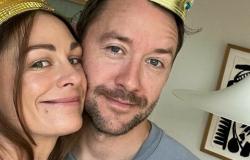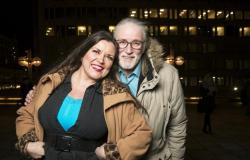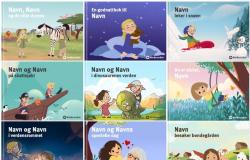Who decides which species are threatened, what kind of plants are allowed to be collected, and what must be left standing?
Can nature management and protection be used as a means of power in the oppression of a people?
These are among the questions raised in Jumana Manna’s exhibition at Kunsthall Stavanger.
SUBTLE BEAUTY: On the end wall of the art gallery, Manna has created a beautiful textile collage. Here she plays different shades of blue against each other, from turquoise, via navy blue to pale purple. There is undoubtedly a colorist sensitivity in the expression, but the color tones are so harmonious that if it were not for the holes, stains and lass in the surface, which create excitement and variation, it would almost become a bit boring and decorative. But here the texture stands in a kind of opposition to the colouring, which becomes quite effective. I also like how the beams in the blind frame shine through and form a grid pattern as a strict counterbalance to the more dissolved textile expression.
Photo: Erik Sæter Jørgensen
Jumana Manna (b. 1987) was born in the USA and raised in Jerusalem.
We like to refer to her as a Norwegian artist, since she was educated in Oslo and has been active on the Norwegian art scene for so many years.
Several times she has also bravely thrown herself into the Norwegian identity debate, and she also represented Norway at the Venice Biennale in 2017.
EDUCATED IN NORWAY: Jumana Manna began her art studies in Jerusalem, before traveling to Norway and the Oslo Academy of Arts. She later moved back to the United States and earned a master’s degree in aesthetics and politics. Today she lives and works in Berlin.
Photo: Mariam Mekiwi/Hollybush Gardens
With the exhibition “Break, Take, Erase, Tally”, Kunsthall Stavanger invites us into Jumana Manna’s well-formed and socially engaged world.
Here it is about everything from agriculture and nature conservation to science and law.
ON THE SHELF: An installation consists of a large black stand with various elements on the different shelves. Some are hard and clean cut, while others are more organic. One element resembles a water tank, on another shelf we see something reminiscent of ceramic jars and vases. The whole is characterized by a fine rhythmic composition, which is unfortunately partly disturbed by the large, black shelf, which steals far too much of the attention. Presumably, she thinks of the shelf elements as black lines that should form a strict counterbalance to the various more organic, ceramic form elements, but I still think that the expression would gain a lot from replacing the dominant black shelf with a more discreet variant, for example in beige.
Photo: Erik Sæter Jørgensen
Protection or abuse of power?
I sit down in a soft pile of cushions and watch the hour-long film “Foragers”.
Here the loss of an old Palestinian tradition is depicted.
For generations, Palestinians have gathered the free-growing herbs ‘ackoub and za’atar, both for domestic use and for sale. For many years, the Israeli authorities completely or partially put an end to this by declaring these plants as endangered.
A powerful moment in the film is when some of Manna’s own relatives gather herbs in the ruins of the bombed-out village where they once lived.
The film powerfully depicts the subtle oppression and harassment of a people who feel completely marginalized in their own homeland.
FORBIDDEN: In the film “Foragers” we see Palestinians illegally gathering herbs that have been declared endangered by the Israeli authorities.
Facsimile: Jumana Manna
The ban applies to both Israelis and Palestinians, but in practice it is Palestinians who are affected, as they are the ones who have traditionally gathered and eaten the crops. I am not in a position to say anything about whether protection is the right decision.
Facsimile: Jumana Manna
In any case, the film tells heartbreaking stories about how the Palestinians try to defy the decision because they experience it as a pure use of force. We will also see how they are punished with both fines and imprisonment.
It is undoubtedly a strong (and painfully topical) theme, and the film is also full of picturesque moments: reddish-brown topsoil against green vegetation. Yellow herbs against an almost violet sky. Shimmering water that forms an enigmatic mirror in the twilight darkness.
But as a work of film art, it becomes a bit too long and wordy.
Sometimes I struggle to keep up with everything that is communicated. I could wish that the message and narrative could live more in the visual and a little less in the documentary and literary.
With his image-creating ability and power of expression, Jamana Manna could clearly have dared to condense and stylize the message even a little more.
SAVED BY THE SEED VAULT: The film “Wild Relatives” (2017) is also long and wordy. But here, too, the topic is incredibly exciting: It’s about biological diversity and the international exchange of seeds. The film opens with an agricultural center having to be moved from Aleppo to Lebanon due to the Syrian civil war. When the agricultural center was moved to the Bekaadalen, the seed stocks were not taken with them due to the war. The film is about the meticulous process of recreating various lost species with seeds taken from the seed vault in Svalbard. We see the women of the Bekaa valley singing while working in the fields. The conflict between Lebanon and Svalbard, the hot south against the arctic north, forms a tension in the film.
Photo: Erik Sæter Jørgensen
Gripping abstract narrative
The exhibition also embraces several large sculpture installations.
Especially the one she has given the title “Family”, I have a great feeling for.
This is really a poignant, little abstract tale. Between the simple forms, which can perhaps be read as a stylized woman and a man and a dog, a lot happens.
Here we see that she is as aware of the space between the forms as of the forms themselves. But strangely enough, this only applies to the three central figures.
“FAMILY”: The central group works so well compositionally, but I feel that the two sculptures at the outer edge fall a little outside the whole.
Photo: Erik Sæter Jørgensen
Form strength and community involvement
The exhibition is elegantly and neatly curated.
Where the long films are shown, it is nice that the audience can sit or partially lie comfortably.
In both films, sculptures and installations, various ancient stories run together: the Middle East is the cradle of the entire civilization with its ancient pottery tradition, but also the agriculture that originated here in “the fertile crescent” for approx. 10,000 years ago.
It was here that seeds were sown, and it was here that the very first crops were harvested.
“OLD BREAD” (2022): This ceramic installation, which shows bits and pieces of what should be old bread, is about the urban consumer society and all that goes to waste.
Here, she refers to the tradition of presenting leftovers from old bread to anyone who would benefit from it. The bread as a symbol of life and a source of life, but also the abundance that leads to the great accumulation of waste.
Purely form-wise and artistically, I don’t think this works very well. There are far too many elements here, and the newsprint makes the whole even more unmanageable.
Different visual languages
Jumana Manna’s works have clear political undertones throughout.
In “Foragers”, for example, the loss of these herbs is obviously a picture of something much bigger. It is about all the Palestinians who have lost ownership of their land, their land and their property.
As I stroll out of Kunsthall Stavanger, I think that one of the things that makes Jumana Manna so exciting is that she carries different cultures and combines different visual languages in a very expert way. Dthere are always many ways to an understanding of her works.
I hope that she will not rest too comfortably on her laurels, despite her international success. She still has some way to go.
Because at the intersection between her clear aesthetic sense and flaming social commitment lies enormous potential.
Tags: Break Erase Tally Jumana Manna Kunsthall Stavanger Reviews recommendations
-






